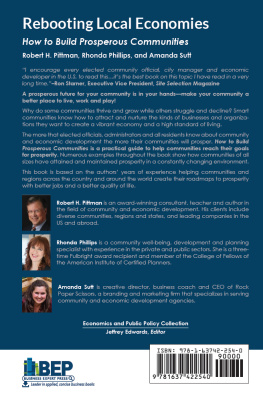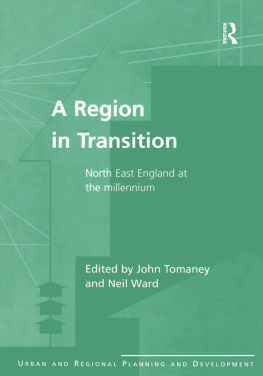COMMUNITY DEVELOPMENT ON THE NORTH ATLANTIC MARGIN
Community Development on the North Atlantic Margin
Selected contributions to the fifteenth international seminar on marginal regions
Edited by
REGINALD BYRON and JOHN HUTSON
University of Wales, Swansea
First published 2001 by Ashgate Publishing
Reissued 2018 by Routledge
2 Park Square, Milton Park, Abingdon, Oxon OX14 4RN
711 Third Avenue, New York, NY 10017, USA
Routledge is an imprint of the Taylor & Francis Group, an informa business
Copyright Reginald Byron and John Hutson 2001
All rights reserved. No part of this book may be reprinted or reproduced or utilised in any form or by any electronic, mechanical, or other means, now known or hereafter invented, including photocopying and recording, or in any information storage or retrieval system, without permission in writing from the publishers.
Notice:
Product or corporate names may be trademarks or registered trademarks, and are used only for identification and explanation without intent to infringe.
Publishers Note
The publisher has gone to great lengths to ensure the quality of this reprint but points out that some imperfections in the original copies may be apparent.
Disclaimer
The publisher has made every effort to trace copyright holders and welcomes correspondence from those they have been unable to contact.
A Library of Congress record exists under LC control number: 2001090207
ISBN 13: 978-1-138-73259-9 (hbk)
ISBN 13: 978-1-315-18836-2 (ebk)
Contents
Tim Jenkins and Nicholas Parrott
Paul Olav Berg
Reginald Byron
Jens Christian Hansen
John Hutson
Alison McCleery
Peter Sjholt
Anne-Marie Sherwood, Nicholas Parrott and Tim Jenkins
Michael Christie
Jrgen Amdam
Susan Hutson and Stuart Jones
Diarmuid Cearbhaill and Tony Varley
Hvard Teigen
Richard Apostle
Reginald Byron and John Hutson
Jrgen Amdam is Professor in the Department of Commune Planning and Administration at Volda University College, Norway.
Richard Apostle is Professor in the Department of Sociology and Social Anthropology at Dalhousie University, Halifax, Nova Scotia, Canada.
Paul Olav Berg is Professor at Nordland University College, Bdo, Norway.
Michael Christie is a Lecturer in the Welsh Institute of Rural Studies, University of Wales, Aberystwyth, Wales.
Jens Christian Hansen is Professor of Geography at the University of Bergen, Norway.
Susan Hutson is Senior Lecturer in the Department of Sociology at the University of Glamorgan, Pontypridd, Wales.
Tim Jenkins is Senior Research Fellow in the Welsh Institute of Rural Studies, University of Wales, Aberystwyth, Wales.
Stuart Jones is a graduate student in Sociology, School of Humanities and Social Sciences, University of Glamorgan, Pontypridd, Wales.
Alison McCleery is Professor in the Faculty of Arts and Social Science, Napier University, Edinburgh, Scotland.
Diarmuid Cearbhaill is Statutory Lecturer in Economics at the International Centre for Development Studies, National University of Ireland, Galway, Ireland.
Nicholas Parrott is a member of the Welsh Institute of Rural Studies, University of Wales, Aberystwyth, Wales.
Anne-Marie Sherwood is a Research Officer in the Rural Economy Research Group at the Welsh Institute of Rural Studies, University of Wales, Aberystwyth, Wales.
Peter Sjholt is Professor of Geography in the Norwegian School of Economics and Business Administration, Bergen, Norway.
Hvard Teigen is Senior Lecturer at Lillehammer University College, Lillehammer, Norway.
Tony Varley is a member of the Department of Political Science and Sociology, National University of Ireland, Galway, Ireland.
This volume brings together a selection of papers which address the theme of the Fifteenth International Seminar on Marginal Regions held in Newfoundland, Canada, in the summer of 1999. As has become customary, the seminar was held in two centres where participants were able to visit local development organisations and enterprise sites. The seminar began in St Johns, from where we visited a number of local communities on the southern shore and studied their problems and opportunities. We then transferred to Terra Nova, where we saw more local economic development problems and projects on the Bonavista Peninsula.
Our hosts for the Seminar were Peter Sinclair, of the Memorial University of Newfoundland, and Richard Apostle of Dalhousie University in Halifax, Nova Scotia. The Atlantic Canada Opportunities Agency gave generous support to the seminar, for which we are most grateful. Our thanks must also go to Sean Cadigan of Dalhousie University, whose knowledge of the history of the communities we visited added a great deal to our appreciation of community development efforts in the region.
The editors have endeavoured to do justice to the wide range of papers given at the Seminar. We hope that the selection chosen will interest a wide variety of specialists and practitioners with interests in the economic and social welfare of communities on the North Atlantic margin.
PART I
NEW PERSPECTIVES ON COMMUNITY DEVELOPMENT
TIM JENKINS AND NICHOLAS PARROTT
Introduction
The Rural in Society
Rural areas in the Europe of today are characterised by three key features. Firstly, they are subject to processes which originate beyond the immediate locale (Lowe, 1996), and they respond in contrasting ways to the demands and opportunities facing them. Marginal rural areas, usually characterised by unfavourable farm structures and relative economic isolation, are likely to respond less positively than more favoured areas, thereby becoming even more marginal. Inter-linkage between the global and the local is particularly evident in the agricultural sector where local production of foods may be directly affected by global agreements and by global supply and demand trends (Marsden et al., 1990). Secondly, rural areas are increasingly characterized by diversity---in populations, economies and lifestyles. Rural areas are increasingly sites of new economic activities (e.g. tourism and recreation) as well as agricultural production, a post-productivist diversity which is the result of the in-migration of new people (Murdoch and Marsden, 1994) and policy encouragement. Thirdly, and most importantly in the context of this paper, rural areas are increasingly seen as both sites of consumption and as commodities in themselves. An increasingly key aim of rural policy is to satisfy public demand for high quality rural environments. The establishment of regional imagery and the production and consumption of quality products are both integral ingredients in such development.








